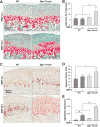Extracellular Matrix Mediates BMP-2 in a Model of Temporomandibular Joint Osteoarthritis
- PMID: 28419987
- PMCID: PMC5540778
- DOI: 10.1159/000464102
Extracellular Matrix Mediates BMP-2 in a Model of Temporomandibular Joint Osteoarthritis
Abstract
Temporomandibular joint (TMJ) osteoarthritis (OA) is a complex disease that affects both cartilage and subchondral bone. It is accompanied by loss of extracellular matrix (ECM) and may be controlled by bone morphogenetic protein-2 (BMP-2). We analyzed the effect of BMP-2 in both cartilage and subchondral bone in a TMJ-OA animal model that is deficient in biglycan (Bgn) and fibromodulin (Fmod) (Bgn-/-Fmod-/-). Whole mandibles were dissected from 3-week-old wild-type (WT) and Bgn-/-Fmod-/- mice and incubated with and without 250 µg/mL BMP-2 for 2 days using an explant culture system. Condyle growth was measured by microCT and the expression levels of cartilage and bone-related genes were analyzed using RT-PCR or by immunohistochemistry from condyles that contained an intact cartilage/subchondral bone interface. Osteoclast activity was estimated by tartrate-resistant acid phosphatase (TRAP) staining and by TRAP, Rankl, and Adamts4 mRNA expression levels. Our results showed that most parameters examined were slightly up-regulated in WT samples treated with BMP-2, and this up-regulation was significantly enhanced in the Bgn-/-Fmod-/- mice. The up-regulation of both catabolic and anabolic agents did not appear to positively affect the overall growth of Bgn-/-Fmod-/- condyles compared to WT controls. In summary, the up-regulation of both anabolic and catabolic genes in the WT and Bgn-/-Fmod-/- TMJs treated with BMP-2 suggests that BMP increases matrix turnover in the condyle, and, further, that Bgn and Fmod could have protective roles in regulating this process.
Keywords: Biglycan; Fibromodulin; Growth factors; Mineralization; Osteoclasts; Turnover.
© 2017 S. Karger AG, Basel.
Conflict of interest statement
There are no conflicts of interest to disclose.
Figures





Similar articles
-
Role of subchondral bone during early-stage experimental TMJ osteoarthritis.J Dent Res. 2011 Nov;90(11):1331-8. doi: 10.1177/0022034511421930. Epub 2011 Sep 13. J Dent Res. 2011. PMID: 21917603 Free PMC article.
-
Biglycan and fibromodulin have essential roles in regulating chondrogenesis and extracellular matrix turnover in temporomandibular joint osteoarthritis.Am J Pathol. 2010 Feb;176(2):812-26. doi: 10.2353/ajpath.2010.090450. Epub 2009 Dec 24. Am J Pathol. 2010. PMID: 20035055 Free PMC article.
-
Analysis of microarchitectural changes in a mouse temporomandibular joint osteoarthritis model.Arch Oral Biol. 2009 Dec;54(12):1091-8. doi: 10.1016/j.archoralbio.2009.10.001. Epub 2009 Nov 6. Arch Oral Biol. 2009. PMID: 19896116 Free PMC article.
-
Temporomandibular Joint Osteoarthritis: Pathogenic Mechanisms Involving the Cartilage and Subchondral Bone, and Potential Therapeutic Strategies for Joint Regeneration.Int J Mol Sci. 2022 Dec 22;24(1):171. doi: 10.3390/ijms24010171. Int J Mol Sci. 2022. PMID: 36613615 Free PMC article. Review.
-
Pathological mechanism of chondrocytes and the surrounding environment during osteoarthritis of temporomandibular joint.J Cell Mol Med. 2021 Jun;25(11):4902-4911. doi: 10.1111/jcmm.16514. Epub 2021 May 5. J Cell Mol Med. 2021. PMID: 33949768 Free PMC article. Review.
Cited by
-
Molecular signaling in temporomandibular joint osteoarthritis.J Orthop Translat. 2021 Sep 10;32:21-27. doi: 10.1016/j.jot.2021.07.001. eCollection 2022 Jan. J Orthop Translat. 2021. PMID: 35591935 Free PMC article. Review.
-
Roles of Ihh signaling in chondroprogenitor function in postnatal condylar cartilage.Matrix Biol. 2018 Apr;67:15-31. doi: 10.1016/j.matbio.2018.02.011. Epub 2018 Feb 12. Matrix Biol. 2018. PMID: 29447948 Free PMC article.
-
Fibromodulin - A New Target of Osteoarthritis Management?Front Pharmacol. 2019 Dec 10;10:1475. doi: 10.3389/fphar.2019.01475. eCollection 2019. Front Pharmacol. 2019. PMID: 31920661 Free PMC article. No abstract available.
-
Conditional Knockout of PKC-δ in Osteoclasts Favors Bone Mass Accrual in Males Due to Decreased Osteoclast Function.Front Cell Dev Biol. 2020 Jun 9;8:450. doi: 10.3389/fcell.2020.00450. eCollection 2020. Front Cell Dev Biol. 2020. PMID: 32582715 Free PMC article.
-
CTX-II and YKL-40 in early diagnosis and treatment evaluation of osteoarthritis.Exp Ther Med. 2019 Jan;17(1):423-431. doi: 10.3892/etm.2018.6960. Epub 2018 Nov 12. Exp Ther Med. 2019. PMID: 30651816 Free PMC article.
References
-
- Albilia JB, Tenenbaum HC, Clokie CM, et al. Serum levels of BMP-2, 4, 7 and AHSG in patients with degenerative joint disease requiring total arthroplasty of the hip and temporomandibular joints. Journal of orthopaedic research : official publication of the Orthopaedic Research Society. 2013;31(1):44–52. - PubMed
-
- Ameye L, Young MF. Mice deficient in small leucine-rich proteoglycans: novel in vivo models for osteoporosis, osteoarthritis, Ehlers-Danlos syndrome, muscular dystrophy, and corneal diseases. Glycobiology. 2002;12(9):107r–116r. - PubMed
-
- Billings PC, Fiori JL, Bentwood JL, et al. Dysregulated BMP signaling and enhanced osteogenic differentiation of connective tissue progenitor cells from patients with fibrodysplasia ossificans progressiva (FOP) Journal of bone and mineral research: the official journal of the American Society for Bone and Mineral Research. 2008;23(3):305–313. - PMC - PubMed
Publication types
MeSH terms
Substances
Grants and funding
LinkOut - more resources
Full Text Sources
Other Literature Sources
Medical
Molecular Biology Databases
Miscellaneous

